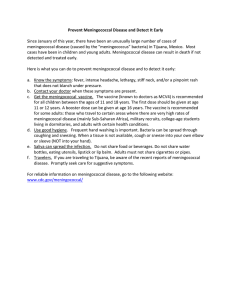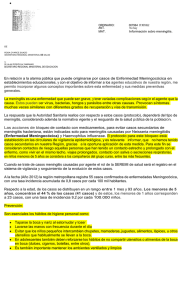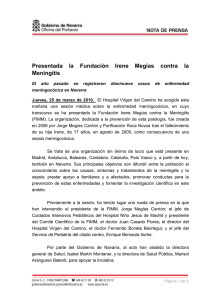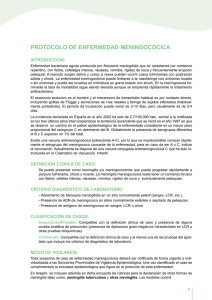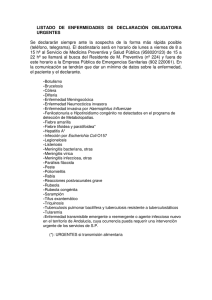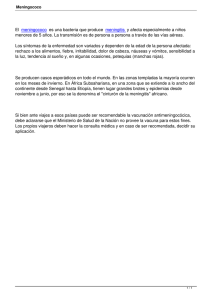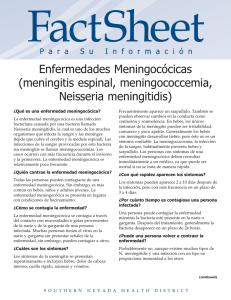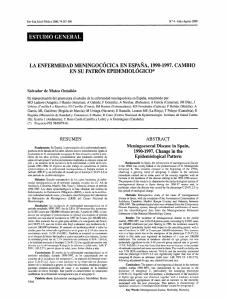Get the Facts - Dickson County School District
Anuncio
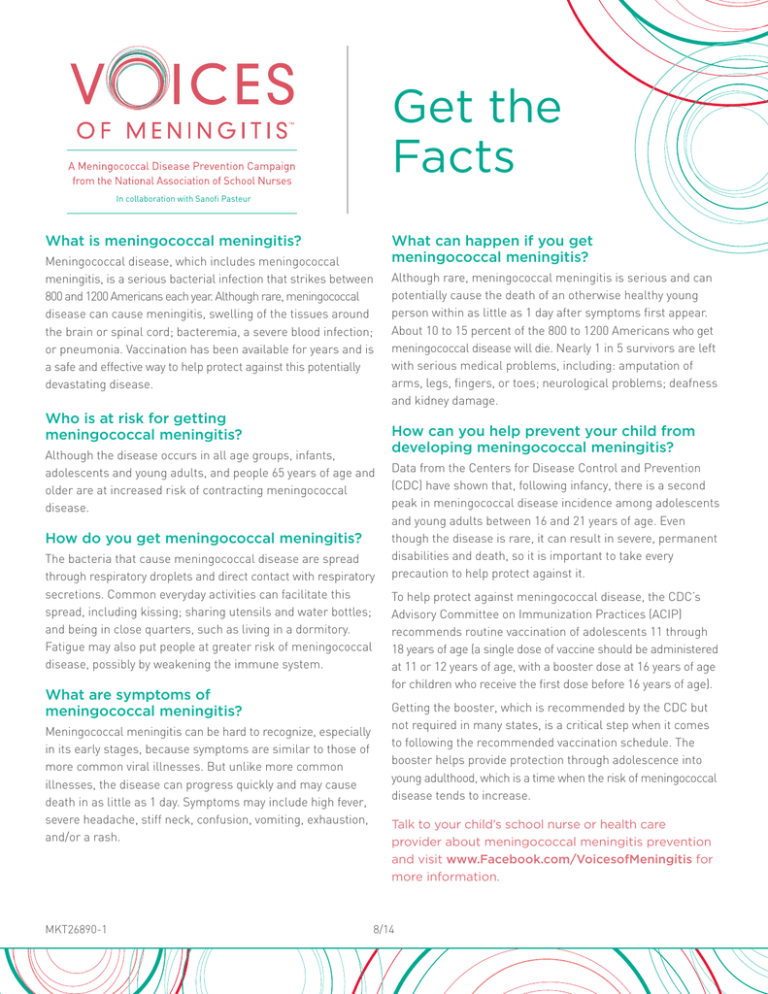
Get the Facts In collaboration with Sanofi Pasteur What is meningococcal meningitis? Meningococcal disease, which includes meningococcal meningitis, is a serious bacterial infection that strikes between 800 and 1200 Americans each year. Although rare, meningococcal disease can cause meningitis, swelling of the tissues around the brain or spinal cord; bacteremia, a severe blood infection; or pneumonia. Vaccination has been available for years and is a safe and effective way to help protect against this potentially devastating disease. Who is at risk for getting meningococcal meningitis? Although the disease occurs in all age groups, infants, adolescents and young adults, and people 65 years of age and older are at increased risk of contracting meningococcal disease. How do you get meningococcal meningitis? The bacteria that cause meningococcal disease are spread through respiratory droplets and direct contact with respiratory secretions. Common everyday activities can facilitate this spread, including kissing; sharing utensils and water bottles; and being in close quarters, such as living in a dormitory. Fatigue may also put people at greater risk of meningococcal disease, possibly by weakening the immune system. What are symptoms of meningococcal meningitis? Meningococcal meningitis can be hard to recognize, especially in its early stages, because symptoms are similar to those of more common viral illnesses. But unlike more common illnesses, the disease can progress quickly and may cause death in as little as 1 day. Symptoms may include high fever, severe headache, stiff neck, confusion, vomiting, exhaustion, and/or a rash. MKT26890-1 What can happen if you get meningococcal meningitis? Although rare, meningococcal meningitis is serious and can potentially cause the death of an otherwise healthy young person within as little as 1 day after symptoms first appear. About 10 to 15 percent of the 800 to 1200 Americans who get meningococcal disease will die. Nearly 1 in 5 survivors are left with serious medical problems, including: amputation of arms, legs, fingers, or toes; neurological problems; deafness and kidney damage. How can you help prevent your child from developing meningococcal meningitis? Data from the Centers for Disease Control and Prevention (CDC) have shown that, following infancy, there is a second peak in meningococcal disease incidence among adolescents and young adults between 16 and 21 years of age. Even though the disease is rare, it can result in severe, permanent disabilities and death, so it is important to take every precaution to help protect against it. To help protect against meningococcal disease, the CDC’s Advisory Committee on Immunization Practices (ACIP) recommends routine vaccination of adolescents 11 through 18 years of age (a single dose of vaccine should be administered at 11 or 12 years of age, with a booster dose at 16 years of age for children who receive the first dose before 16 years of age). Getting the booster, which is recommended by the CDC but not required in many states, is a critical step when it comes to following the recommended vaccination schedule. The booster helps provide protection through adolescence into young adulthood, which is a time when the risk of meningococcal disease tends to increase. Talk to your child’s school nurse or health care provider about meningococcal meningitis prevention and visit www.Facebook.com/VoicesofMeningitis for more information. 8/14 Infórmese ¿Qué es la meningitis meningocócica? ¿Qué puede suceder si se contrae meningitis meningocócica? La enfermedad meningocócica, que incluye la meningitis meningocócica, es una infección bacteriana grave que afecta de 800 a 1200 estadounidenses por año. Aunque es poco frecuente, la enfermedad meningocócica puede causar meningitis, inflamación de los tejidos que revisten el cerebro o la médula espinal: bacteriemia, una infección sanguínea grave; o neumonía. La vacunación existe desde hace décadas y es una manera segura y eficaz de ayudar a proteger contra esta enfermedad potencialmente devastadora. Aunque es poco frecuente, la meningitis meningocócica es grave y puede causar la muerte de una persona joven y sana en tan solo 24 horas. Entre un 10 y un 15 % de los 800 a 1200 estadounidenses que contraigan la enfermedad meningocócica fallecerán. Aproximadamente 1 de cada 5 sobrevivientes padece secuelas médicas graves, que incluyen: amputación de brazos, piernas, dedos de las manos o de los pies; problemas neurológicos; sordera y daño en los riñones. ¿Cómo puede ayudar a prevenir que su hijo desarrolle meningitis meningocócica? ¿Quiénes corren riesgo de contraer meningitis meningocócica? Si bien la enfermedad se presenta en todos los grupos etarios, los lactantes, adolescentes, adultos jóvenes y las personas de 65 años en adelante corren mayor riesgo de contraer la enfermedad meningocócica. ¿Cómo se contrae la meningitis meningocócica? La bacteria que causa la enfermedad meningocócica se propaga a través de las gotículas respiratorias y por medio del contacto directo con las secreciones respiratorias. Las actividades diarias habituales pueden facilitar esta propagación e incluyen besarse, el uso compartido de utensilios y botellas de agua y permanecer en espacios reducidos, como convivir en un dormitorio estudiantil. La fatiga también puede exponer a las personas a un mayor riesgo de contraer la enfermedad meningocócica, posiblemente a causa del debilitamiento del sistema inmunológico. ¿Cuáles son los síntomas de la meningitis meningocócica? Puede ser difícil reconocer la meningitis meningocócica, especialmente en sus primeras etapas, ya que los síntomas son similares a los de otras enfermedades virales más comunes. Pero, a diferencia de estas enfermedades más comunes, la meningitis puede avanzar rápidamente y causar la muerte en tan solo 24 horas. Los síntomas pueden incluir fiebre alta, dolores de cabeza fuertes, rigidez en el cuello, confusión, vómitos, agotamiento y/o erupción en la piel. MKT26891-1 Los datos de los Centros para el Control y la Prevención de Enfermedades (Centers for Disease Control and Prevention, CDC) han demostrado que, después de la lactancia, existe un segundo pico en la incidencia de la enfermedad meningocócica entre adolescentes y adultos jóvenes de 16 a 21 años. Si bien la enfermedad es poco frecuente, puede provocar discapacidades graves y permanentes, incluso la muerte, por lo que resulta importante tomar todas las precauciones posibles para evitar contraerla. Para ayudar a prevenir la enfermedad meningocócica, el Comité Asesor sobre Prácticas de Inmunización (Advisory Committee on Immunization Practices, ACIP) del CDC recomienda la vacunación de rutina en adolescentes de entre 11 y 18 años (se debe administrar una dosis única de la vacuna a la edad de 11 ó 12 años y recibir una dosis de refuerzo a los 16 años en niños que reciban la primera dosis antes de los 16 años). Colocarse el refuerzo, que recomienda el CDC pero que muchos estados no exigen, es un paso fundamental en el cumplimiento del cronograma de vacunación recomendado. El refuerzo brinda protección desde la adolescencia hasta los primeros años de la edad adulta, que es una etapa en la que el riesgo de contraer la enfermedad meningocócica tiende a aumentar. Hable con la enfermera escolar o el proveedor de atención médica de su hijo sobre la prevención de la meningitis meningocócica o para programar una cita de vacunación y visite www.Facebook.com/VoicesofMeningitis para obtener más información sobre la meningitis meningocócica y su vacunación. 8/14
